
Gina Beavers
“…one could see the extermination camps as the culmination
of a long process of the ‘destruction of reason’ – of the
humanist reason inherited from the Enlightenment – to use
Georg Lukács’ phrase. But their structure, at the intersection
of several modern experiences and institutions (barracks, penitentiary,
slaughterhouse, factory and bureaucratically rational
administration), and their ideology (racial biology) remained
the product of a European historical trajectory spread over
several centuries, whose general line had been traditionally
interpreted as humanity’s forward march towards Progress.
This trajectory now proved to be the antechamber to hell.”
Enzo Traverso
“For the interregnum of the post-war years is over. We are experiencing a return of the great fear, as if it never ended—and perhaps it never did.”
Robert Hullot-Kentor
Here in Norway, recently, several members of the new government, including the education minister, spoke of people who had influenced them growing up. Three of them, including new education minister Torbjørn Røe Isaksen listed Ayn Rand. Isaksen also listed Hayek and Edmund Burke. This, for him, constituted a sound place to start one’s socio political education, he added. Now this is the first time the Labor party hasn’t held power in something like 25 years. And the new pro corporate party (Hoyra) formed a coalition with a further right part, the FRP, who are basically the Norwegian version of an anti immigration party. Of course the former head of the Labor Party, Jens Stoltenberg, is now running NATO — so maybe this shift is pretty miniscule, actually. My point is not to go into Norwegian politics, but only to suggest that this shift (because seriously, Labor still retained certain very traditionally Scandinavian qualities, for the good) is representative of a cultural shift toward the new fascism. I don’t think that that is at all too strong a statement. I mean liking Ayn Rand just makes you a philistine, someone with no taste and maybe a lot of resentment, but Burke? Hayek? This is deeper and more telling. And all together, with no Marx, no Freire, no Fanon…that’s distressing.

Maya Lin
In a country that suffered the Anders Breivik attack, it also suggests a certain cognitive dissonance. But then, I find that quality in U.S. culture, too. This week also saw Sean Penn write an article about his clandestine meeting with cartel boss El Chapo. If you happened to read the Penn piece, the most striking quality was the 5th grade level prose, the really rather jaw dropping immaturity and narcissism — and, perhaps most sadly — the terrible need to be taken seriously. The second most striking quality of this *story* is that it does not fully add up. Whatever collusion occurred, clearly the DEA and CIA had a huge hand in finding the right narrative and tone. But my favorite passage of Penn’s is this:
“It became evident that the peasant-farmer-turned-billionaire-drug-lord seemed to be overwhelmed and somewhat bewildered at the notion that he may be of interest to the world beyond the mountains.”
De coded this reads…It became evident that peasants and drug lords alike are stupid and backward, especially in the presence of a MOVIE STAR.
This was also the week of the No-Snack militia in Oregon. And much has been written on the Bundy take over, and most of it correct and obvious. But one thing I wanted to note, odd as it may sound, is that all these guys look alike. Beefy (overweight), bearded, wearing those Chris Kyle shades (which you see on literally every Blackwater employee ever..Wiley X Saint if you are interested). It is the gestalt image of white resentment. In all of them there is something that registers as both angry and terrified. And insecure. Hiding behind beards and dark glasses and usually fourteen thousand ammo belts and combat knives and canteens etc. And usually in camo of some sort. And in shades. Nothing is revealed. The caricature of hyper masculinity is acutely painful, really.

Church of St. Bernadette. Nevers, France. (Parent and Virilo, architects). 1963.
So, on the one hand, these stories are distractions. But all of the above, together, is part of a general sense of this normalizing of fascism that is occurring the West.
Enzo Traverso wrote, in 1999, an interesting and often profound, if not unflawed and in places problematic, book called Understanding The Nazi Genocide. A few years later he wrote The Origins of Nazi Violence. Both are compelling reads. One of the things Traverso focuses on in the first book is the idea that firstly, Hitler’s final solution was not foundational to National Socialism. It developed in stages. And second, that Hitler came to conflate Jew with Bolshevik. That the camps of the *final solution* were mostly on the eastern front, essentially, seems an instinctive gesture from the high command. But Traverso also sees Hiroshima and Nagasaki as the other two poles of modern barbarism. The Nazi *conveyor belt* — work camp to killing camp, was a product of both Hitler’s own long standing hatred of Jews, but also an expression of the Nazi ideal of efficiency and progress. I.G. Farben, maker of Zyklon B, had factories employing Jewish camp labor. And the camps themselves were modeled on factories. The fact that it became clearly MORE expensive to exterminate Jews and Gypsies and others did not prevent the Nazi’s from doing so, and hence under this patina of organizational expertise lay a hugely irrational system of racial hatred and homocidal mania. A regression, yes, but a product of an evolution in irrationality and barbarism. The Nazis and fascists in general were representing the Volkish nativism of Aryan kitsch legends, but also a fetishized belief in progress. There is a curious contradiction that National Socialism expressed, and that is Teutonic regressions of an idealized super race against a backdrop of sun dappled Alpine meadows — but also a meticulous and deep belief in progress, in technology and rationality. It was not simply a regression to some former fantasy. It was a new fantasy making use of old material.

Zach Harris
Traverso writes…“far from overturning bourgeois civilization, socialism would complete its work by going ‘beyond’ it, and thus realising all its potentialities. They thus forgot Marx, in whose eyes the Russian socialists should have drawn inspiration from the Slav peasant commune (obshchina) rather than from English industry.”
Marx, in the Communist Manifesto even, points out the bourgeois tendency toward an immersion in “the icy
water of egotistical calculation”. For Marx (especially writing on colonialism in India) saw both the civilizing mission and social regression.
Marcuse saw in the death camps…“the unrepressed implementation of the achievements
of modern science, technology, and domination.”
“Traditional semi-feudal and petty-bourgeois anti-semitism
… led to pogroms, which were to the Nazi murderers what
knives are to the atom bomb. The seeds of the gas
chambers resided in the mass enslavement and killing of
Blacks via the slave trade, in the wholesale extermination of
the Central and South American Indians by the conquistadors.
In such cases, the term genocide is fully justified.”
Ernest Mandel
The colonialist felt their technology *proved* their superiority. No manner of crime was too great, too vicious and sadistic and wanton to dent this deep seated sense of European superiority. The British in Kenya and India, the French in North Africa and the Caribbean, and the Dutch in south east Asia, the Spanish all over the new world…all of this contained the most savage cruelty and barbarity. But nothing made a dent in the idea of European science and progress. And it culminated…per Traverso…in WW2. Now, the real fulcrum is probably more WW1 (which is the focus of Traverso’s 2nd book), but that’s another entire topic. For what interests me here is this idea of what constitutes *progress*. What images are associated with this word and term? And how progress interfaces with domination. And what post moderrn progress might look like.
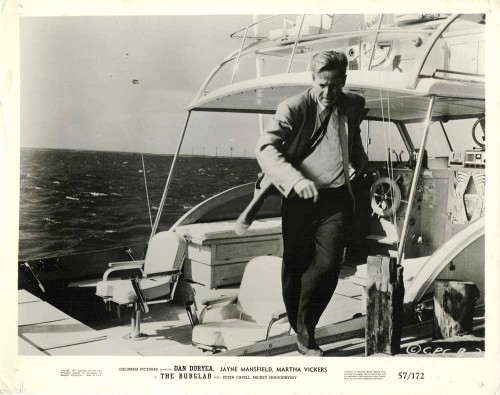
The Burgler (Wendkos, dr.) 1957
Much 20th century art, meaning mostly Modernism, but not entirely, was an expression of distrust in progress. And that today, the idea of scientific progress has reestablished itself in both the post modern world of theory (despite much ostensible disavowal) but also in a surging wave of very right wing white historical writing and in mass media and entertainment. It is also ‘geek progress’. Steve Jobs is enshrined as one of the great men of his day — despite my not grasping what exactly he did that is so remarkable. Bill Gates, the same thing; but there is another branch of this idolatry of science and technology, and that is the military. Science gave the world Hiroshima and THEE most efficient device for human extermination. Progress is linked up with notions of what is efficient. And that in turn is linked up with Capital and waste…mostly wasting time, but waste in general. And maximizing profit means lowering the amount of time wasted by your workers. So, here there are contradictions in the sense that nobody wastes money quite the way the military does. And yet, NOT wasting things is a sign of progress itself. So the narrative that is produced here is one in which the military is depicted as high tech, and wired, and a model for futuristic efficiency. It is not seen as menial and boring and routine. Chris Kyle meets Steve Jobs meets Gordon Gecko.

Ursula Von Rydingsvard
Adorno saw in his essay (or his collaboration) on the Authoritarian Personality, the following qualities in the reactionary, or those raised in fascist or authoritarian climates; conventionalism, submission to authority, aggression, susceptibility to superstition, power and toughness, destructiveness and cynicism, projectivity, and outsized and Puritanical notions about sex. Sounds like the Bundy militia. But never mind, the authoritarian personality must believe, finally, in progress — no matter the amount of nostalgia for foundation myths or kitsch fairy tale narratives of one’s own race or class that one is steeped in. Looking back at the mid 20th century phase of modernism, I would argue, for example, that much brutalist architecture is actually a protest against progress, against the hegemony of technological achievement. Virilo and Parent’s Church at Nevers, France, looked at today feels oddly like a defiant child who refuses the clothes his mother bought for him. There is a curious production of ‘backward’ affect. A sense of neo primitivism, but it is also, simultaneously, albeit subtly, both gentle and almost nurturing. Brutalism is always teetering on some thin line between purification and excess, between austerity and hedonism. And this is true, too, of much painting from this period. This marked the last collective distrust of conformity. For everything that came after, say, 1970, had almost by default, contained some kind of ironic perspective. The Church at Nevers is not ironic. And I think the best of Brutalism is never ironic. But it is, even the good work, often hostile to the scale of the human. There felt a reaction against Brutalism, from the 80s onward that is only now reversing again. The best Brutalists buildings suddenly look pretty good when compared to much contemporary architecture. Buildings such as Le Corbusier’s government complex in Chandigarh, India, are recognized, rightly, as masterpieces, while others have gone through varied critical positions, or like the Prentice Women’s Hospital in Chicago, a building I happen to think is quite significant, are demolished. The best of Brutalist architecture today appears almost modest, and certainly emphasizes a material place in lieu of self marketing.
There is something lurking in discussions on power and authority that has to do with how we *look* at things. I actually think Chris Kyle’s being a sniper was the perfect storm of sorts for a new archetype or symbol of the new fascism. Kyle is the unseen killer, the viewer of death. He is an individualized A bomb. A long distance Zyklon B. Stanley Cavell has said the voyeurism of film has to do with not presenting the world, but by allowing the viewing of the world, privately. So that it is not a wish to dominate, but a desire to not have to dominate. And there is certainly, I think, truth in this. For in the surveillance age, the ability to lose oneself in a cinema is very seductive. I do think, however, that Cavell is wrong in the sense that the relief felt from not having to dominate, is more like relief from not having to dominate, while still dominating. It is a relief from being yourself seen while dominating. Being watched watching cinema is always slightly unseemly, even pornographic. Film narrative, storytelling, had throughout the evolution of the medium been the predominant means for film expression. Cinema always felt closer to the novel than theatre, for example. Why this is, to me anyway, remains something of the mystery. However that may have happened, or evolved, the ascension of film as the quintessential art-form of the late 20th century is impacted by, and impacts everything else, because of actors. Or rather, performers. An actor in a film is simply doing something very different than an actor on stage. Putting that aside for a second, the saturation of film and TV has meant a saturation of performances. Daily life today is profoundly influenced by *acting*. By recorded acting. And it is the acting of a narrative. And perhaps one has to further tweeze apart the particular kind of narrative that can be acted on screens.

Marshland (La isla minima), 2014. Alberto Rodríguez Librero, dr.
Acting in film (on film?) has to do very much with absence. In that sense it is a migration of that quality of listening found in acting on stage. The film actor does not listen, but he looks. He looks at, often, a *nowhere*. A place off screen. But that is far too simple. The actor looks — and perhaps it is irrelevant what that actor looked at the moment this scene was filmed, but more important is that that place, the place of the look, is going to always be an historical look. And if that is true, then any number of actor’s looks in films are allegorical. This raises certain rudimentary technical questions; the reverse shot, or reaction shot, is exempt in this sense. But the actor alone on screen looking out past the audience is always looking at a place in the past. It is the psychoanalytical past, however, it is the missed appointment. But it likely many other things as well.
And this then, touches on a number of additional issues. I wrote last time about reality TV. And in reality TV, as in all improvisation for actors, the sense of place disappears. For the look is linked to the recited text. The scripted text. And this is the deepest mystery, possibly, in all discussions of film and TV. Sound — recorded sound — in film is critically important, in the sense that it must meed the technical threshold for the removal of identifiable ambiance. The actor must, via technical means, be talking to us. If we hear the residue or vestiges of the set, of location, of that day, that hour, that moment in which the scene was shot, then all of the magic of the cinema is gone. In this sense the voyeurism of film is about the production of intimacy. Monica Vitti in her Antonioni films is always talking to us. She speaks to us in such intimacy that it becomes almost unbearable. When Welles narrates in Lady From Shanghai, the intimacy forecloses on the story. We must acquiesce and submit. The voyeuristic submission is the existential fact of cinema art, I think.
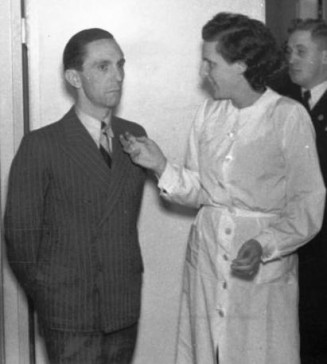
Goebbels & Riefenstahl, 1937.
One of the reasons that Cahiers du Cinema lost importance when Bazin died, and after the short periods of Rohmer and Rivette’s editorships, was that the magazine abidicated the primacy of the auteur theory. But the auteur theory was never really about the auteur theory. And what got lost under Comolli and Narboni was the sense of filmic allegory as an approach, which was contained in the approach of auteur theory. If much was gained in the investigation of the material production of the film business, the losses (and Godard knew this) were much greater. For the auteur theory was a sensibility about cinema. And that sensibility recognized, intuited, that an Edgar Ulmer or Paul Wendkos directed films that transcended all rational explanation in the experience of viewing them — it was never to suggest Wendkos was a genius. But for a complex of reasons and factors, Wendkos was the man with directing credits on several remarkably surreal movies from the late fifties and early sixties. Cahiers, during its seminal period was transcribing something significant about the predominant art form of the century. Nobody else would have grasped the importance of a Sirk, or of the early Preminger.
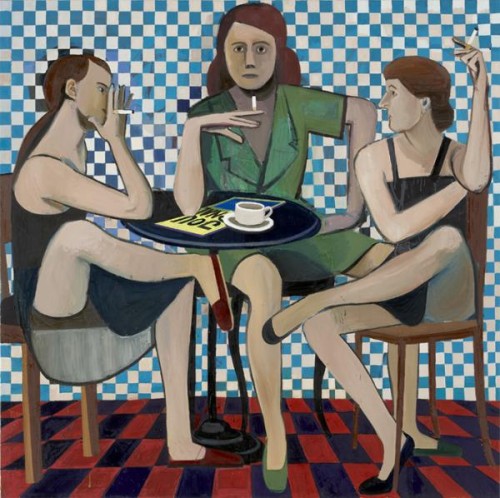
Christoph Ruckhaeberle
The out of frame effect, what Barthes called the *punctum*, in photography, is not at all the same thing as I suggest is involved in cinema. The relation however does involve something of this lost gaze, or interrupted gaze. The missing element, cut off by the edge of the photo, and a castration symbolized by the click of the shutter; in that sense, in cinema, the punctum is produced by dialogue. The click of the shutter is unnecessary because there is the residue of repetitions, that recitation from memory, performed speech that exists nowhere else but in theatre and film. And in film it is once removed from the immediacy of the stage, but in that distance something else accrues, something to do directly with being visible to the recording camera. A submission to be an exhibit. To be open to further investigation and study. And that quality of longing, of melancholy, that is in Bresson and Ozu is directly related to excessive rehearsal. The actor, again, as a vehicle for the return of the repressed. But all this occurs in the most elliptical and nomadic manner. Christian Metz said film was too big to be a fetish in the same way as photography.
Cinema, however, also carries with it something linked to ideas of progress. It is an obvious technology, and one that is constantly innovative about its own technical parameters. So much so, that contemporary film feels as if it is suffocating beneath the weight of its relationship to the technical. The best films I have seen over the last few years are uniformly modest in technical terms. Most recently, Marshland (La isla mínima), from 2014, a Spanish noir directed by Alberto Rodríguez Librero. Set in post Franco Spain, the story of the murder of two girls in an Andalusian small town is more about the legacy and shadow of years of Fascist rule. It is a reflective and unsettling and finally very painful portrait of how societies, like people, cannot escape their past. Not right away, anyway.

Elementary School, Aesch Switzerland. Forderer, Otto, & Zwimpfer, architects.
Leni Riefenstahl’s vision was one that in its own peculiar genius, resided in am embrace of the fetishistic that only an unapologetic authoritarian could express. Her late color photos of the Nuba people in the Sudan are perhaps the quintessential fetishizing by the white colonial. The oddities of Riefenstahl’s later life (she lived until she 101) include a film project with L. Ron Hubbard (a remake of The Blue Light, her 1930s drama as a musical, which fell apart due to funding shortages) and celebrity portraits such as those of Mick and Bianca Jagger. That Hitler’s visual stenographer could navigate the ruling class until her dotage should hardly be surprising, but I mention this because in a sense her two Nazi films, especially Triumph of the Will, and her 1954 curiosity Tiefland, a melodrama about a Spanish dancer (played the forty-ish Riefenstahl herself), are both to be read as fascist mythology (in very different ways) but also register as uncomfortable and morbid due to a mise-en-scene that both fixates on bodies, but eliminates that which animates them. Actors, performers, simply don’t look in Riefenstahl’s cinematic world. She might well have been the perfect director for Terminator.
Judith Thurman wrote of Riefenstahl:
“Her love for the Führer was the paradigm of her self-entrancement, and she never disavowed it, although she later expressed some mild distress at the atrocities perpetrated in his name. Her life after the war would have been much easier if she had, but to do so was to betray something more essential than loyalty to a dead master. It was to endanger the ruthless suspension of self-doubt that her identity had, from childhood, depended on. And in one respect it was logical for her to love Hitler: he had the insight to recognize what her love could give him—a perfect reflection of itself.”
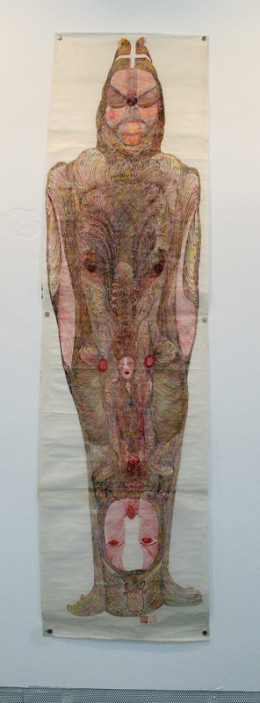
Guo Fengyi
Progress, it seems to me, cannot really be separated from the contemporary form of acute narcissism. In that sense, like Traverso’s insights on National Socialist mythology, today’s new crypto-fascist semi stealth mythologizing is interconnected with a deep almost slavish worship of self and the self’s progress. Albeit a phantom self, but more on that below. It is the logical outcome, though, I think, of the deformed development of science and Capitalism. Progress was and is inseparable from the narrative of the self.
“The victory of the bourgeoisie is the victory of profoundly historical time, because this is the time of economic production which transforms society, continuously and from top to bottom. So long as agrarian production remains the central activity, the cyclical time which remains at the base of society nourishes the coalesced forces of tradition which fetter all movement. But the irreversible time of the bourgeois economy eradicates these vestiges on every corner of the globe. History, which until then had seemed to be only the movement of individuals of the ruling class, and thus was written as the history of events, is now understood as the general movement, and in this relentless movement individuals are sacrificed. This history which discovers its foundation in political economy now knows of the existence of what had been its unconscious, but this still cannot be brought to light and remains unconscious. This blind prehistory, a new fatality dominated by no one, is all that the commodity economy democratized.”
Guy Debord
The narrative of the self as one of self improvement. Progress. Progress toward completion. There is only the vaguest of ideas associated with what this completion would look like. Society, following the Enlightenment and Industrial Revolution, is viewed today as a narrative of progress (well, white Western progress). The regressive factor in the myth of contemporary versions of the Enlightenment is one that has returned to a belief in certain unchanging Natural laws– only now these are increasingly expressed in personal terms — human nature (and its stunning how much new-age mush filters into popular discourse and gets hardly a notice). The self, the subject, whose progress stands in for society, is working on self improvement while understanding that this self improvement leads to a union with and more perfect realization of the Natural self (which is variously defined as fulfilled, thriving and happy, or at peace). The vague ideas of completion are vague ideas of restoring a union with Nature, with natural law, and in this sense the new reactionary revisionists of history are working to restore nostalgic volkish mythology in new techno but natural fiber clothes. The core new age posture, evolved over a thirty year period, is at heart a pretty regressive and conformist one, but also one redolent of most fascist mythology — it is fetishizing self by way of self help industry bromides, yoga classes, spin classes, and vegetarianism. (Remember Hitler was a vegetarian, at the end anyway…but then so am I). In one sense, the popularity of cinema and TV is that within this voyeuristic submission there is found a reproduction of submission to eternal forces of nature, which also not coincidentally are racial and class based, and nationalistic. This new nationalistic jingoism that one sees in Chris Kyle and the Bundy Militia, and one saw in Anders Breivik, is highly regressive and almost infantile, and it is entrenched in working class white males. The men hiding behind beards and teflon vests and Wily X sunglasses are enraged fat kids who feel everything they are entitled to is being stolen from them. Their story, their mythology is being stolen (at the crudest level this is found in stuff like The War on Christmas, etc). The University educated white classes, smugly tolerant (up to, you know, a point) are the ones importing whatever version of Werner Erhard is available, coupled to a worship of ruling class pedigree. Increasingly the affluent classes openly acknowledge their love for the rich. This may well have always been true, but it was covert. Today it is not.
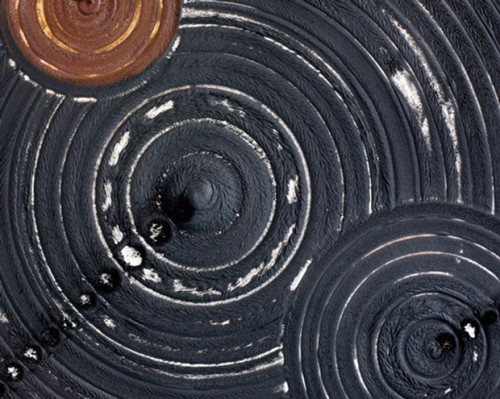
Sungfeel Yun
The domination factor, the occularcentric tradition of Western culture is then one where screen narratives substitute for praxis of any sort. Spectator life. Except in private. Voyeuristic, but dominating. In fact, what Cavell suggests, that relief from *having* to dominate remains true, I think, only domination is now so normalized that it is misidentified. American football, the agent for brain trauma, and steeped in a homophobic misogynist culture of abuse and stigmatizing and shaming is described as character building and healthy. The University rape culture is one in which scapegoating mechanisms now operate in hyper speed and intensity. The mechanisms of scapegoating have no time or space to actually work. But no matter, because another action of domination is waiting. And another. The endless stories of predator priests in the Catholic Church are simply compartmentalized because the kitsch version, Hollywood version, of that narrative cannot be stopped. There is no pause button.

Wiel Van der Randen, photgography.
“Adorno and Horkheimer thus highlight the paradoxical situation of individual
existence that arises within the modern rationalistic age—to survive
men must at one and the same time annihilate themselves. This relationship
between ‘self-preservation’ and ‘self-destruction’ is explained through reference
to the nature of modern science, its application to the natural world
through technology and the capitalist economic imperative. The argument
rests on the inversion of man’s domination over nature into its opposite. Modern
means of production reflect this inversion through the repetitive cycle
of technological production. Through technology, human beings work incessantly
upon what ‘is’, i.e. that which through positivist science is perceived as
unchanging and formal nature. In their relations to the machine (as a virtual
appendage) they reflect the never-ending sameness of nature through their
own repetitive and unchanging work.”
David Seymour (Adorno and Horkheimer: Enlightenment
and Antisemitism)
And Debord’s well known quote here…
“The spectator’s consciousness, imprisoned in a flattened universe, bound by the screen of the spectacle behind which his life has been deported, knows only the fictional speakers who unilaterally surround him with their commodities and the politics of their commodities. The spectacle, in its entirety, is his “mirror image.” Here the stage is set with the false exit of generalized autism.”

Prentice Women’s Hospital, Chicago. Bertand Goldberg, architect.
The narrative of the self is spoken on screen by fictional characters. Listened to, preferably, in private. The images themselves now read not viewed. And that sound, the performance, is increasingly suppressed. In a stunning number of new TV shows there are characters who are managed from a control room — or advised by an all seeing expert (usually a sexy young woman). The expert functions a bit like a drone pilot, directing the protagonist to his target. Or destination, which is in fact usually a target. The normalizing not just of surveillance, but of voluntarily giving away the ego. In a sense this is the new technological super ego.
Adorno and Horkheimer saw one aspect of the dialectic of Enlightenment being the suspension of metaphysics. And this sense of the self critical has gone missing in art for the most part, today. But that missing self interrogation is felt, and therefore replaced with pseudo self criticism. Much conceptual art, and much performance art and now much of that second or third generation of performance and identity art is what has come to stand in for metaphysics. Cindy Sherman ushered in (partly) this new appearance art, or the appearance-of-critical-self-examination art. Someone once asked me in a workshop the difference between Mamet and Pinter. This was during the early Mamet period. And I had to think on it, but the answer was metaphysics. There is no metaphysics in Mamet because there never is in fascists. I shouldn’t say never, but almost never. The evolution of Western art from, say, 1950 to 2016 has been one in which there has been a steady removal of a genuine *outside*. The outside is that which science and rationality cannot master, and politically it is the unruly masses and the poor. Hence they are made invisible. In the narrative of the self, the masses and poor are consigned to the periphery the better to stay focused on ‘taking care of myself’.One paradox in this is that science, theoretical physics for example, has increasingly become about what cannot be seen and maybe can’t even really be there. And this induces a kind of panic because if the most rarefied theoretical mathematics and physics is going to end up as pure philosophy, then the society that erases that which it cannot master is going to have to erase such rarefied disciplines. And perhaps that is already happening.
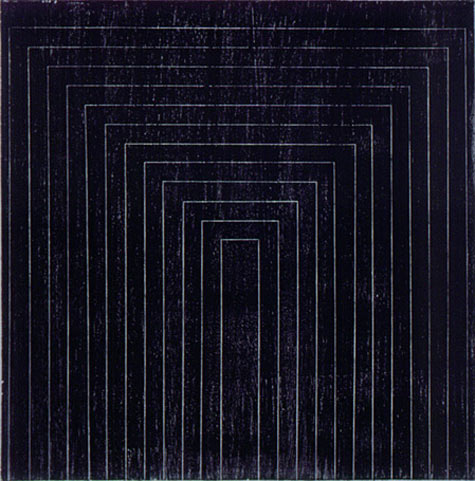
Lygia Pape
The double character of progress, as Adorno termed it, is really only the idea that emancipation, liberation, and autonomy carry their shadow opposite within them. And when artworks can no longer distinguish between conformity and anti-conformity, the society itself has reached a place of regression. For at some point, there is an accumulative affect that cannot be fully repressed in people. And contradictions can no longer be so successfully hid. In the U.S. today the mass shooting phenomenon is treated with theatrical shock and surprise. How could this happen? What are we to do?? The asking of such questions, and in fact the asking of any rhetorically structured general question, one directed tacitly at society itself, is already an agreement to be obedient. And much of social media, oddly, reinforces this internet subject position, notwithstanding the shocking number of doxxings and outings and shameings and trollings that go on. But that is only cyber road rage in a sense but it ties in with a larger current running through popular culture in the form of social media which is a consensus with the status quo. In both the right wing (where the jingoism is most pronounced and sort of old fashioned) and in the soft left and liberal left, who are not really leftist at all (where common sense has replaced fascist myth making almost exactly) the inclination is always to see the status quo, the government, or mass media, as correct and to be sided with. The consigning of disruptive forces is accomplished by, in most cases, tagging them with the label of *conspiracy theorist*.

SESC Pompeia São Paulo, Lina Bo Bardi, architect.
The influence of cinema and TV is almost certainly even greater than most critics, and myself, imagine. I think at times, maybe it is almost everything, in terms of how we think and what we say. So a final observation or two on this idea of intimacy in cinema. I think all great directors grasp this, intuitively at the least. It has been said that the ear is efficient for up to twenty feet and that after that its effectiveness, certainly for conversation, erodes. The eye can, obviously see far further. Possibly the most seductive aspect of film is the ability to be whispered to at a distance usually reserved for vision. All conversation, all quiet talks between characters — even if on TV or your laptop, and certainly on a cinema screen, has a hypnotic quality and I suspect this quality accounts for a certain appeal associated with certain settings; offices or workplace areas. For these are usually alienated and oppressive areas, stress inducing, but rendered *intimate* and personal and private. And private even if one watches it with someone else or several other people on a laptop screen. This is the uncanny aspect of the reading of screens. Of actors reciting lines, documented by a camera and reproduced countless times.
At the same time, this is a faux intimacy, a pre-recorded intimacy. And while there is mimesis, as a fact of almost inter relationships with an artwork, there is also a sense of seer and seen, and in screen mediums it is not reciprocal. In psychoanalysis it is also not reciprocal. But it is non-reciprocal in a different way. And this is a continuation, however mediated, of the guard and prisoner. This is the Panopticon model again, but also the model of all clinics. And it is the base structure of all surveillance. The hidden microphone that records conversations raises questions that, I think, immediately come to mind. The sense of optical penetration feels far deeper and more violent than audio eavesdropping. The visual verification eludes audio recording. One does not feel as if one can re-narrate and situate a space when just listening (and this speaks to the much neglected magical quality of radio drama). The visual is the watcher and watched, known or not, and it is closer and quickly closer, to notions of control.
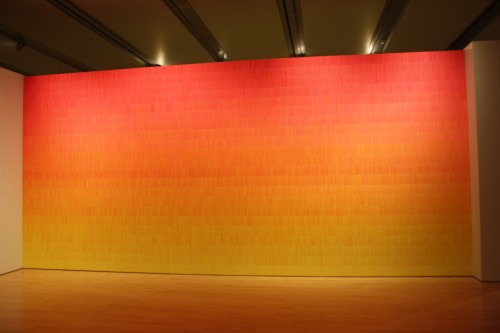
Peter Wegner
The phallic aspect of optical privilege is secondary, but one instinctively senses the aural as more feminine. One seems to absorb sound. Close your eyes and concentrate on the music. Shut off sounds and only watch. One remains an attack and one a retreat. The well trod theoretical path of Mulvey and the male gaze is apt, to a point, but I think there are far more complex factors involved in film, and often they are overdetermined, and that in fact is another quality of film and TV. In a late letter Horkheimer wrote to Adorno, he said…“Language intends, completely independent of the psychological intentions of the speaker, that universality that has been ascribed to reason alone.” He goes on to add that language, if it is to support the status-quo, must constantly contradict itself. And this is where we are today with a lexical hegemony of screen product and creation. Horkheimer also added that to speak to someone is to recognize them, and to recognize them as potential colleagues in social change. He used the speech of the concentration camp guard as an example of this contradiction that must occur in the dominated society. The film actor speaks to nobody, but he speaks words that are not his or hers, and this recording now shapes this evolving field of human discourse — speech and performance. For when is speech not a performance? How is a pogrom narrated? A lynching? In the death houses of U.S. prisons, the chamber for lethal injection is sound proofed. Curtains open and the ‘audience’ views the show.

Cinema dislocates the physicality of the theatrical audience, unbinds it. The human intimacy of live performance doesn’t so much vanish as apotheosize, and it’s different from the abstractly placed ‘reader’ or reading audience of books. The film audience now is particularising, becoming atomic like the literary, but in the second half of the 20th c. it was aggregate exactly like the theater, but it wasn’t anywhere. There and not there. The living paradox.
Reifenstahl is an important case study for any scenster when it comes to what folks compromise for the myth of access.